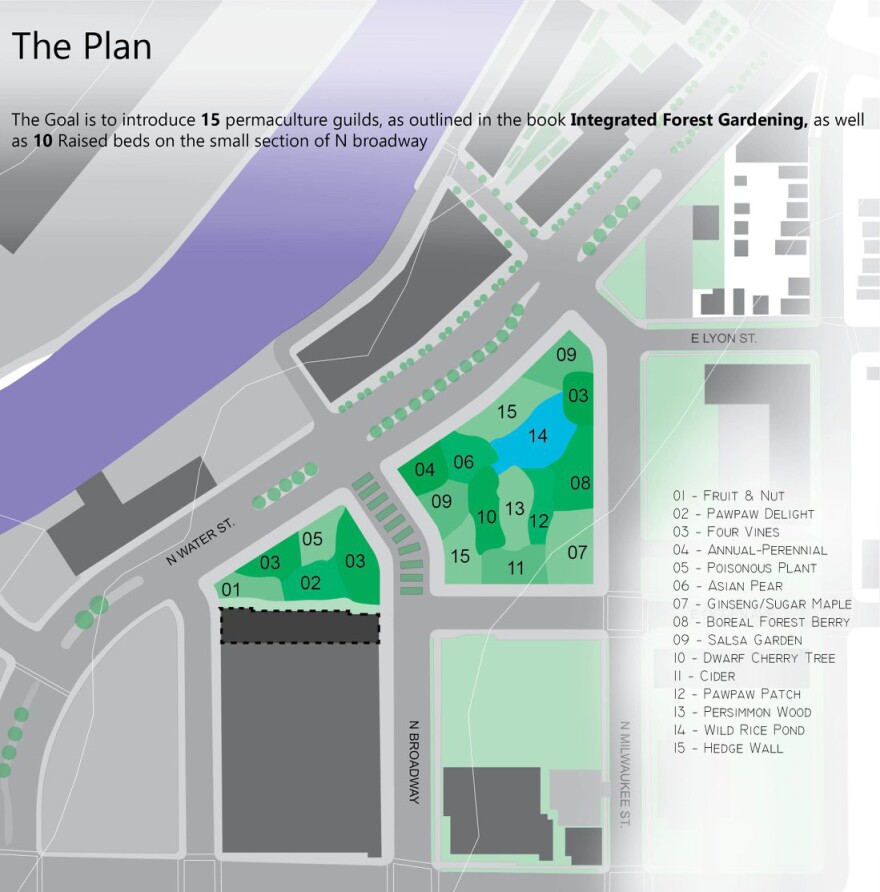Some cities are embracing the idea of edible urban forests. Food Forests have taken root in places like La Crosse, Wis., and Seattle, Wash.
Now, a Milwaukee advocate is trying to create a 2.2-acre version. Barbara Richards hasn't chosen one of the city's many empty lots, but one of its most popular areas – the Park East Corridor, just north of downtown.
It’s what remained after crews removed a former freeway spur in 2002. Today the Fiserv Forum development dominates the 24-acre corridor. To its east, apartments and businesses have bubbled up along the Milwaukee River.

The empty lot's high point is at the corner of Milwaukee Street and Ogden Avenue. A handful of trees dot the plot that slopes toward the Milwaukee River.
Richards, a retired Montessori teacher who's now a very busy community volunteer, imagines lots of trees here.
"This would be a much denser planting of trees and companion plants that grow together," she says.
Richards' edible forest would contain different tree species. Each would form the upper story of plants and vegetables that thrive beneath it.
"There's things that are in the ground that bring up the nutrients. There's things that capture the sunlight at all the different levels," she explains.

Her vision is based on permaculture. It’s the practice of growing food the way nature does, and in the process, she says you grow healthy soil.
Richards says the urban model also fuels a healthy human ecosystem. People can help tend the plants, just pop in to enjoy the shade, or feel free to pick a fruit or veggie off of the vine.
At the same time, Richards' model manages stormwater.
"So swales and stormwater harvesting on each side," Richards' says. "And then a small pond down there that would be a wild rice pond. Then an underground cistern for pumping up and watering all of the plants."
READ: Green Infrastructure Helps Manage Water In Milwaukee's Urban Landscape
Milwaukee School of Engineering (MSOE) is a hop, skip and jump from the site. Richards says MSOE students would benefit from this living laboratory.
"Measuring the rainfall, seeing how much is captured, how much is used. Often when there's all of this vegetation, there’s very little runoff into our Milwaukee River," Richards says.
?t=29
Richards speaks as though the urban food forest has already taken root, its meandering paths offering neighbors respite and a fresh piece of fruit. That’s because Richards started dreaming this dream eight years ago.
"About 3 feet from where we are right now, I was out and about downtown and I was hungry so I bought a couple of peaches. I ate the peaches, and I planted the peach pits there in 2011. That's also when the WICCI report came out," Richards says.
WICCI stands for the Wisconsin Initiative On Climate Change Impacts. The collaborative work group issued an adaptation report in 2011. It inspired Richards to act.

“We need to have local resiliency and that’s what this site is a message to our whole community. That the local resiliency can only be had by being local,” Richards says.
Richards’ vision is gaining some traction.
“I have a fiscal sponsor. The fiscal sponsor has approved that we could go forward with this project. However, the paperwork from the county is intense – there has to be a development plan, there has to be a proposal to purchase. Those are being reviewed by a lawyer at this time,” Richards says. “The project budget is $2 million over five years, that’s an estimate.”
That means Richards continues to knock on doors, hoping to sell what she calls an opportunity for powerful collective impact.
Have an environmental question you'd like WUWM's Susan Bence to investigate? Submit below.
_







